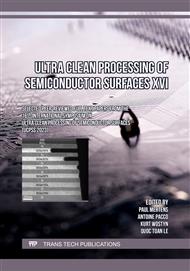p.311
p.318
p.325
p.331
p.335
p.341
p.346
p.351
p.356
Controlled and Uniform Wet Etching of Molybdenum Nanowires
Abstract:
We achieved the controlled recess of molybdenum (Mo), which is alternative interconnect material for copper (Cu), by wet chemical etching. This wet etching process includes two main steps which are chemical oxidation of Mo and its subsequent dissolution, respectively. Firstly, Mo nanowires (NWs) are uniformly oxidized with potassium permanganate (KMnO4) solution in acetone. Secondly, the Mo oxide is dissolved using an aqueous solution of HCl. Mo NWs are characterized through transmission electron microscopy (TEM) imaging after each of the above steps. Cyclic etching experiments including oxidation and dissolution of Mo showed that Mo recess is linear and can be controlled for each cycle, where the etching produced the smooth Mo surface. This controlled Mo recess is crucial for the fabrication of next-generation metal interconnects.
Info:
Periodical:
Pages:
351-355
Citation:
Online since:
August 2023
Keywords:
Price:
Сopyright:
© 2023 Trans Tech Publications Ltd. All Rights Reserved
Share:
Citation:


